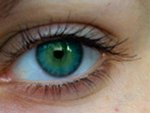 Odds are, you will one day build something someone will see. Here are three key findings from people who study how people see to keep in mind for your next project.
Odds are, you will one day build something someone will see. Here are three key findings from people who study how people see to keep in mind for your next project.
Eyes are not cameras
Cameras move slowly, smoothly and continuously. They pan, zoom and tilt. Eyes don’t do any of these things, and the first thing you need to know about the eye is that it is nothing at all like a camera.
The eye has two basic states: it can be in a fixation or a saccade. A fixation lasts between 200 and 400 ms and is characterized by a relative lack of eye movement. A saccade is the brief, simultaneous movement of both eyes to a new fixation point. Saccades typically last less than 200 ms, in which time the eyes usually rotate less than 20 degrees. Very little information is retained or processed from the eye when in a saccade. (Saccades are pretty cool – if you’re interested, there’s been a lot of research on how the brain tricks itself into believing it receives a continuous feed of information from the alteration of saccades and fixations.)
What this means to you: Readers will navigate your website in a series of short glances followed by short hops. You need to keep related content close together, or it becomes a chore to navigate.
You don’t always see what you’re looking at
At GazeHawk, we refer to this as the ketchup-bottle problem after Brian‘s tendency to spend 10 minutes looking through the fridge for a bottle of ketchup that’s right in front of his face. Here’s the idea: your eyes are always on. But even when you want to be paying attention, your conscious mind cannot process the majority of the information the eyes are sending up. So you pick and choose what you want to pay attention to, and what you simply don’t see.
My favorite demonstration of this is the famous “selective attention test” a.k.a. the Monkey Business Experiment. For those not familiar with this, watch the video first.
The experimenter asked participants in the study to watch a video of two teams dribbling basketballs. The participants were instructed to count the number of times one team passed the ball. Unbeknownst to them, in the middle of the video a man dressed a in a gorilla suit walked into the shot, pounded his chest, and walked off. About half the study participants did not notice this happening.
It’s difficult to measure the extent to which this happens in daily life; after all, how do you know what you’re missing? And how do you design a web page knowing that people tend to miss things that are right in front of them? Keep it simple. If there’s only one thing on the page, it’s hard for them to miss it.
What this means to you: People can only absorb so much information at once. Do not expect them to “get” more than one thing at a time.
Faces, faces, faces
The brain comes pre-equipped with special processing centers for the detection, recognition, and processing of faces. While these systems develop as people age, infants as young as two months old have exhibited a preference to look at faces as opposed to other objects.
What does this mean for hackers? Human beings have an innate, insatiable urge to look at faces. If you put a picture of someone’s face on a website, almost everyone will look at it. If that face is near the top of the page, it is likely to be the first thing everyone looks at.
Here’s where it gets cool: not only do people love to look at faces, but we often use them as clues as to where else to look. Following a person’s gaze is almost a reflex. James Breeze demonstrated this really well in a blog post called “You look where they look.” His experiment was simple: about 100 people were shown a picture of an advertisement with a baby and some text. Half the time, the baby was facing the reader, while the other time, the baby was looking at the text. Breeze found that not only did the people shown the baby looking at the text pay more attention to the text, but they actually stopped looking at the baby faster in order to follow its gaze.
What this means to you: Be very careful when putting important visual cues or content near pictures of faces.
That’s it for this now. My next few posts may include more eye-tracking findings and a study of the eye movement of redditors.


very informative, brief and ‘punchy’ material
Wow you guys seem to be learning a whole ton while working on your startup! Who knew working on a technology startup would drive people to researching eyes, sweet!!!
Thanks for the tips. I see what you are saying.
Great article. Following a person’s gaze makes a lot of sense. I will try it next project.
Thanks.
Cool article – this info is definitely relevant when building a web app!
Pingback: Article: What everyone should know about the human eye « Articles Journal
Very interesting and useful information. Please, bring us more on this subject.
Pingback: Apple Is the Macro Situation
Pingback: Experienced users view Reddit differently | GazeHawk Blog
Pingback: Call to Action Buttons | QR Codes | Eye-Tracking | Conversionator V2 N31 | Diamond Website Conversion
Pingback: Where do users look first? | GazeHawk Blog
Pingback: What else you should know about the human eye | GazeHawk Blog